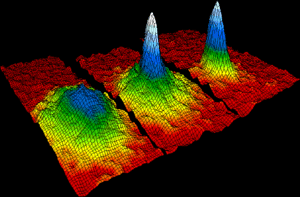Thermal physics facts for kids
Thermal physics is a branch of physics that studies how heat, temperature, and energy work. It looks at how tiny particles behave in large groups. This field combines three main areas: thermodynamics, statistical mechanics, and kinetic theory.
It helps us understand everything from why ice melts to how engines work. It's all about the movement and energy of atoms and molecules.
Contents
What is Thermal Physics About?
Thermal physics explores how physical systems behave when we look at their energy. It starts with the basics of heat and temperature. Then, it dives into the first law of thermodynamics and second law of thermodynamics. These laws explain how energy moves and changes.
This field also studies entropy. Entropy is a measure of disorder or randomness in a system. Imagine a messy room; it has high entropy! Thermal physics helps us understand this disorder using quantum theory.
Tiny Particles and Energy
A key idea in thermal physics is how likely it is for particles to be in certain energy states. It looks at things like photons (particles of light) and phonons (particles of sound or vibration). These particles show how waves of light and vibrations in materials are similar. Both need quantum theory to fully understand them.
Thermal physics also covers many other interesting topics:
- Chemical potential: How energy changes when particles are added or removed.
- Ideal gas: How gases behave at a tiny, quantum level. This includes fermions and bosons, which are different types of particles.
- Bose-Einstein condensation: A special state of matter where particles act like one big wave.
- Gibbs free energy and Helmholtz free energy: Ways to measure useful energy in a system.
- Chemical equilibrium and phase equilibrium: When chemical reactions or states of matter (like solid, liquid, gas) are balanced.
- Equipartition theorem: How energy is shared equally among different ways a particle can move.
- Entropy at absolute zero: What happens to disorder at the coldest possible temperature.
- Transport processes: How heat, energy, or particles move through materials. This includes mean free path (how far a particle travels before hitting another), viscosity (how thick a liquid is), and conduction (how heat moves through a material).
Tools for Studying Thermal Physics
Scientists use special tools to study thermal physics. These tools help them measure and control heat and energy. There are two main types: meters and reservoirs.
Meters: Measuring Tools
A thermodynamic meter is any device that measures something about a system. For example, a thermometer measures temperature. The zeroth law of thermodynamics helps us understand how thermometers work. It says that if two objects are both in balance with a third object, they are also in balance with each other. This means we can use a thermometer (the third object) to compare the temperatures of other things.
An ideal thermometer would be a gas that stays at a constant pressure. It would not change the temperature of what it is measuring.
Reservoirs: Big Storage Systems
A thermodynamic reservoir is a very large system that can store or give out a lot of heat or energy without changing its own state much. Imagine a huge ocean. If you drop a hot pebble into it, the ocean's temperature won't change noticeably. The ocean acts as a temperature reservoir.
It's important that meters and reservoirs are different. A thermometer should not act like a temperature reservoir. If it did, it would change the temperature of what you're trying to measure, giving you a wrong reading. Ideal meters are designed not to affect the system they are measuring.
Related pages
See also
 In Spanish: Física térmica para niños
In Spanish: Física térmica para niños


